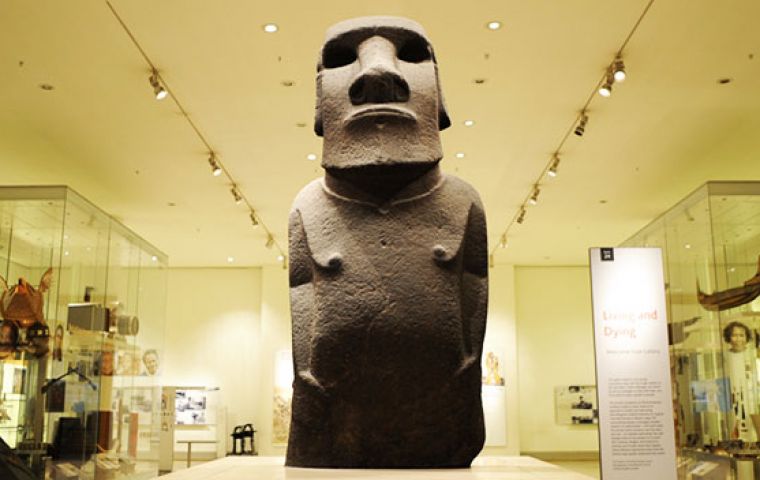MercoPress. South Atlantic News Agency
British Museum asked to return Eastern Island monolith
 The “Hoa Hakananai’a” measures about eight feet in height and weighs an astonishing four tonnes.
The “Hoa Hakananai’a” measures about eight feet in height and weighs an astonishing four tonnes. A delegation from the Chilean Easter Island early this week has asked the British Museum in London for the return of an iconic statue believed to date from around 1200 AD and even offered to replace it with a replica carved from stone by a contemporary artist.
The statue, known as “Hoa Hakananai’a”, meaning “lost or stolen friend,“ was acquired by the British vessel HMS Topaze in 1868. It is highly revered among the indigenous Rapa Nui people whose culture is deeply connected with Moai sculptures and who claim the Easter Island as their ancestral territory.
The “Hoa Hakananai’a” is a Moai basalt monolith which Royal Navy captain Richard Powell presented to Queen Victoria who passed it on to the British Museum.
A spokesman for the British Museum said they were always willing to consider loaning out objects from its collection “subject to the usual conditions.”
Regardless of the implications of those words, Chile's Heritage Minister Felipe Ward described the meeting as ”pretty positive,” while Easter Island Governor Tarita Alarcón Rapu was quoted as crying according to the Guardian, “you have our soul!”
The name of Hoa Hakananai’a translates to “lost or stolen friend,” while the word Moai itself means “ancestor.” It is one of roughly 900 Moai sculptures produced by local islanders in between the 11th and 17th centuries. Each carved monument depicts a glorified figure from the Rapa Nui community, such as tribe leaders.
The statue measures about eight feet in height and weighs an astonishing four tonnes, is said to have intriguing and unique carvings. It has all the typical details of a Moai sculpture: a corpulent profile with a slightly frowning expression, and a single line representing the mouth.
The truly authentic details rest on the backside of the sculpture. Those include depictions of the island’s birdman cult as well as more ritualistic motifs related to the mysterious history of the place.
The indigenous Rapa Nui peoples further regard that Hoa Hakananai’a helped resolve fierce internal clashes between tribesmen on the island, many centuries ago.
It was not the first time the British Museum has been asked to return artifacts to their countries of origin.




Top Comments
Disclaimer & comment rules-

Read all commentsFat chance of the British giving it to Chile...it never belonged to Chile in 1868...it was annexed by Chile in 1888 so arguably the British may have taken one statue, but Chile took the whole island including all the statues...
Nov 24th, 2018 - 12:41 am 0Commenting for this story is now closed.
If you have a Facebook account, become a fan and comment on our Facebook Page!